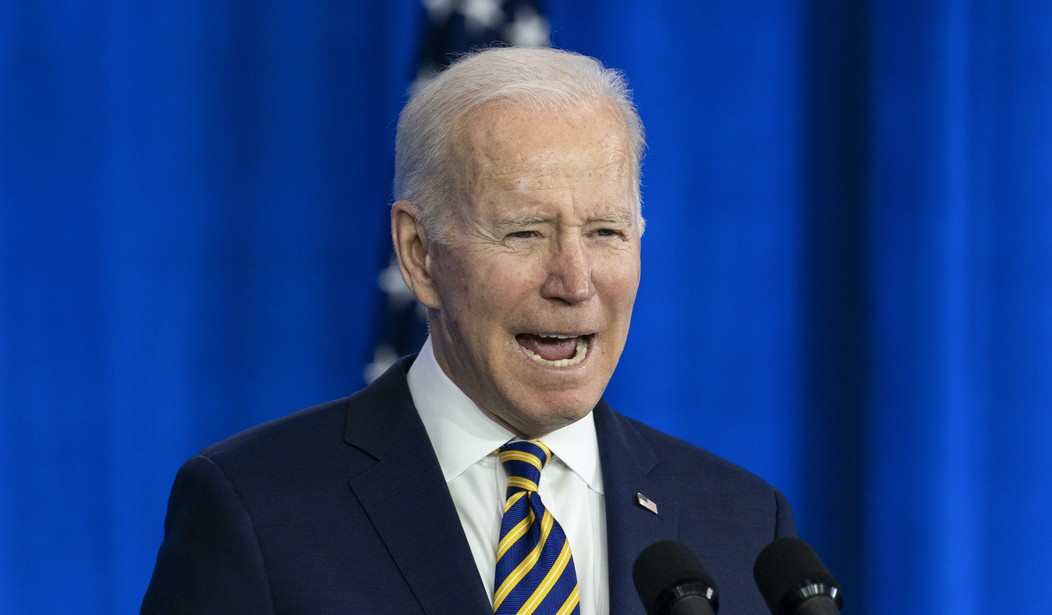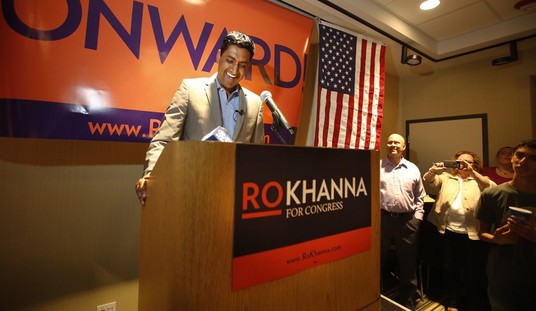This effort, and Joe Biden’s demand for it on a federal level, is almost certainly doomed. At least it allows the New York state legislature to claim that they’ve done something in the wake of a mass shooting in Buffalo, but an age restriction for access to a constitutional right will not likely be “something” for long:
New York’s legislature voted Thursday to ban anyone under age 21 from buying or possessing a semi-automatic rifle, a major change to state firearm laws pushed through less than three weeks after an 18-year-old used one of the guns to kill 10 people at a supermarket in Buffalo.
The bill raising the age limit is the most significant part of a package of gun control measures announced earlier this week by Democratic legislative leaders and Gov. Kathy Hochul.
Other new legislation will restrict civilian purchases of bullet-resistant armor, which was worn by the killer in Buffalo, and require new guns to be equipped with microstamping technology that can help law enforcement investigators trace bullets to particular firearms.
The age limit bill passed the Senate along party lines, 43-20, and in the Assembly 102-47, and will now head to Hochul’s desk for her signature.
Just a couple of hours later, Joe Biden made that a centerpiece demand in his national address on gun violence:
We need to ban assault weapons and high capacity magazines. And if we can’t ban assault weapons, then we should raise the age to purchase them from 18 to 21. Strengthen the background checks, enact safe storage laws and “red flag” laws. Repeal the immunity that protects gun manufacturers from liability. Address the mental health crisis deepening the trauma of gun violence, and as a consequence of that violence.
These are rational, common-sense measures. Here’s what it all means. It all means this: We should reinstate the assault weapons ban on high capacity magazines that we passed in 1994 with bipartisan support in Congress and the support of law enforcement.
Nine categories of semiautomatic weapons were included in that ban, like AK-47s and AR-15s. And in the 10 years it was law, mass shootings went down. But after Republicans let the law expire in 2004, and those weapons were allowed to be sold again, mass shootings tripled. Those are the facts.
Those are not the facts, actually. Glenn Kessler picked each of these arguments apart last week in an omnibus fact check sans Pinocchios, finding that these kinds of mass shootings are actually exceedingly rare while being excruciatingly tragic, and the increase in these incidents is significantly related to population growth (via Scott Johnson at Power Line):
The team, drawing on the existing databases and supplemental research, found that “the number of mass public shootings has indeed increased over the past four and one-half years, particularly over the past decade. However, even at its peak in 2018, the number of such incidents has not surpassed ten in any year, and often has been much lower.” Moreover, some of the increase can be linked to growth in population. The incident count tripled since the mid-1970s but the rate per 100 million of population increased by a factor of two.
Fox told the Fact Checker that most mass shooters are very determined individuals and that even with an average of seven or eight mass shootings a year, new laws might only reduce the number by one a year.
The same researcher rebuts Biden’s arguments on the effectiveness of the AWB, in large part because long-barrel rifles were only used in a small percentage of these incidents:
Fox, in a 2016 study co-written with Emma Fridel of Northeastern University, noted that “rather than assault weapons, semiautomatic handguns are the weapons of choice for most mass shooters.” (About 70 percent of mass public shootings after 1992 relied exclusively or primarily on semiautomatic handguns.) They wrote that “the frequency of incidents was virtually unchanged during the decade when the ban was in effect” and that “not only were there countless assault weapons already on the street, but also assailants had a variety of other powerful firearms at their disposal.”
The new mass-shooting database shows that there were 31 mass shootings in the decade before the 1994 law, 31 in the 10 years the law was in force (Sept. 13, 1994 to Sept. 12, 2004) and 47 in the 10 years after it expired. As noted, some of that increase stems from population growth.
Almost all of this, in other words, is a performative effort to be seen as “doing something.” That might be more true of the age restriction than the other policies expounded by Biden in last night’s address. Despite the push in New York, the Ninth Circuit has ruled a similar California law to be unconstitutional just three weeks ago:
A U.S. appeals court ruled Wednesday that California’s ban on the sale of semi-automatic weapons to adults younger than 21 is unconstitutional.
In a 2-1 ruling, a panel of the San Francisco-based 9th U.S. Circuit Court of Appeals said Wednesday the law violates the 2nd Amendment right to bear arms and a San Diego judge should have blocked what it called “an almost total ban on semi-automatic centerfire rifles” for young adults. “America would not exist without the heroism of the young adults who fought and died in our revolutionary army,” Judge Ryan Nelson wrote. “Today we reaffirm that our Constitution still protects the right that enabled their sacrifice: the right of young adults to keep and bear arms.”
The issue in California parallels New York’s new law in another way. Both states prohibited access to handguns to adults under 21 years of age as well, a major factor in the Ninth Circuit’s reasoning. As the opinion explains, even under intermediate scrutiny that kind of structure substantially deprives adults of access to effective forms of self-defense, violating their civil rights as enumerated in the Constitution:
Handguns are the quintessential self-defense weapon, see Heller, 554 U.S. at 629, but young adults already cannot purchase them, Cal. Penal Code § 27505, 18 U.S.C. § 922(b)(1). And under this ban, they also cannot purchase semiautomatic centerfire rifles. That leaves non-semiautomatic centerfire rifles, rimfire rifles, and shotguns. Non-semiautomatic rifles are not effective as self-defense weapons because they must be manually cycled between shots, a process which becomes infinitely more difficult in a life or death situation. Rimfire rifles generally aren’t good for self-defense either, because rimfire ammunition has “poor stopping power” and are mostly used for things like hunting small game. David Steier, Guns 101, 13 (2011). So for self-defense in the home, young adults are left with shotguns. …
Thus, we hold that California’s ban is a severe burden on the core Second Amendment right of self-defense in the home. Young adults already cannot buy the quintessential self-defense weapon, Heller, 554 U.S. at 629, and this ban now stops them from buying semiautomatic rifles, leaving only shotguns. So handguns aside, this law takes away one of the two remaining practical options for self-defense in the home, and leaves young adults with a self-defense weapon which is not ideal or even usable in many scenarios. That is a severe burden.
More to the point, however, is the question of restricting an enumerated right for a broad class of adults solely on the basis of age. The opinion and dissent both dance around this, with some debate as to the traditions of the age of majority in US law. Never mentioned, however, is the 26th Amendment passed fifty years ago which settled the constitutional definition of majority at 18 years of age:
26th Amendment
Section 1
The right of citizens of the United States, who are eighteen years of age or older, to vote shall not be denied or abridged by the United States or by any State on account of age.Section 2
The Congress shall have power to enforce this article by appropriate legislation.
Oddly, the Ninth Circuit never addressed that in its opinion in Jones v Bonta. If this decision gets appealed to the Supreme Court, however, one can bet that the current slate of justices will find ways to address it. If the Constitution recognizes 18-year-olds as full citizens in regard to access to the right to vote, it at least strongly suggests that age limitations on enumerated constitutional rights that exclude 18-year-olds cannot stand. That does not apply to access to alcohol or tobacco, since neither are guaranteed in the Constitution, but access to firearms is an incorporated individual right that comes directly from the Second Amendment.
In Heller, Antonin Scalia noted the legitimacy of restrictions for specific and limited issues:
Although we do not undertake an exhaustive historical analysis today of the full scope of the Second Amendment, nothing in our opinion should be taken to cast doubt on longstanding prohibitions on the possession of firearms by felons and the mentally ill, or laws forbidding the carrying of firearms in sensitive places such as schools and government buildings, or laws imposing conditions and qualifications on the commercial sale of arms.
That, however, does not contemplate barring access to broad categories of adults on the basis of age.
Like most of what Biden said last night, this idea seems doomed. It might give lawmakers a couple of years of bragging rights about “doing something” before these laws get tossed out, however.







Join the conversation as a VIP Member